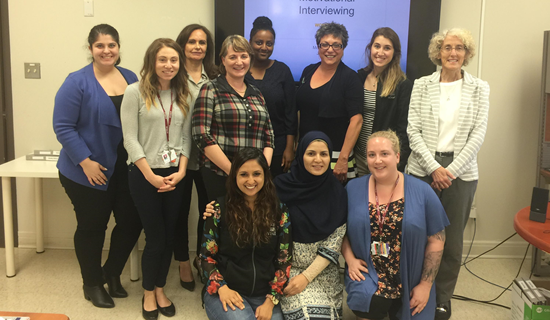
The Access to Resources in the Community team at Bruyère
Simone Dahrouge, PhD: ‘A real success story for patient engagement in research’
11/14/2018
In a recent publication by the Ontario SPOR Support Unit, BRI investigator Simone Dahrouge, PhD, discusses her experience with a pivotal question: does patient engagement in research improve health?
The publication, titled “Engaging Patients in Health Research: the Ontario Experience,” features in-the-trench experiences, tips, and challenges from 17 researchers who consulted patients in the design and execution of their work. Simone’s contribution focuses on the impact of patient partners on her research concerning access to health resources in the community.
Overall, she calls her experience “a real success story.”
Simone launched her research project in 2014 with the goal of improving people’s access to health-enabling community resources in the Champlain area. These resources take a variety of shapes and forms, ranging from fitness classes to mental health support. They can be beneficial to a person’s health, or can complement any treatments prescribed to them by their physician. The issue however is that these resources are often underused.
On one hand patients might simply be unaware that these resources exist. For example, a grocery store might offer free cooking classes with tips on how to eat healthy, but this service may be under-advertised. On another hand, patients may also face personal barriers to accessing these services. This can be due to myriad factors, such as mental health or financial constraints.
Simone’s research explores whether patient navigators can help patients overcome their personal barriers to access the health resources in the community. She focuses on whether patient navigators can help francophone Ontarians overcome language barriers that may be preventing them from accessing a health resource. To guide this work, she consulted with patients who spoke French as a first language. These individuals were involved in Simone’s research from the outset.
“The patient partners provided crucial guidance” she explains. “Especially in terms of defining the scope of the patient navigator’s role.”
Simone also had frequent consultations with 15 other individuals whose jobs or lives could be affected by, or could help influence, the project. She met with them frequently throughout the research study.
“They edited study documentation, reviewed referral and consent forms, survey questionnaires, and promotional materials. They also contributed to result interpretation, giving us vital insight into the significance of our findings,” she explains.
For Simone, this project reinforced the value of working in a collaborative partnership that includes individuals from a variety of different backgrounds—not just research.
Read the full OSSU publication
here.